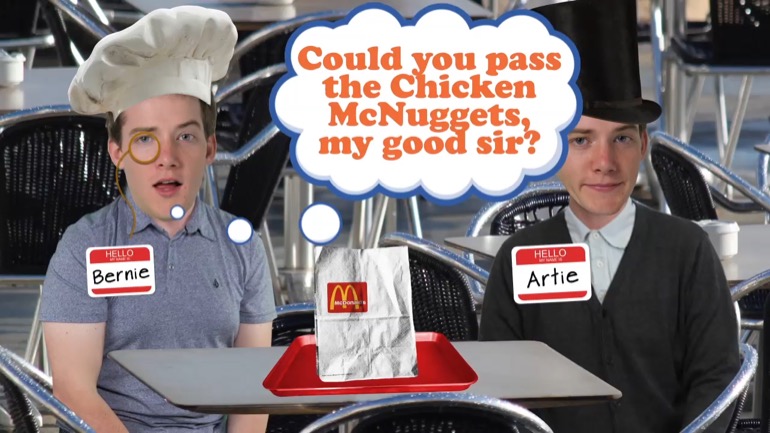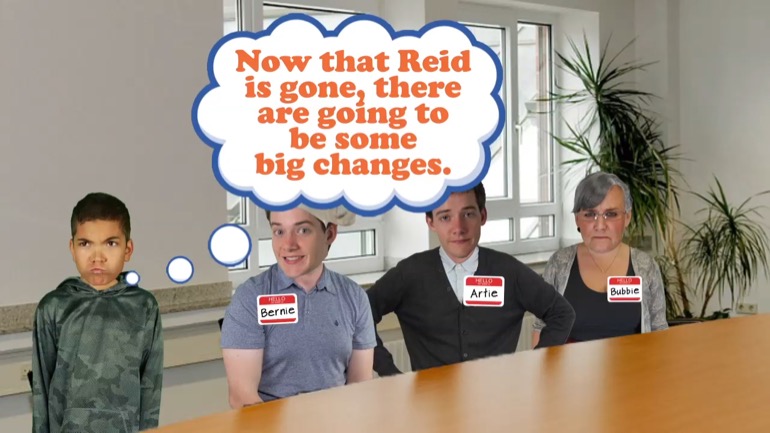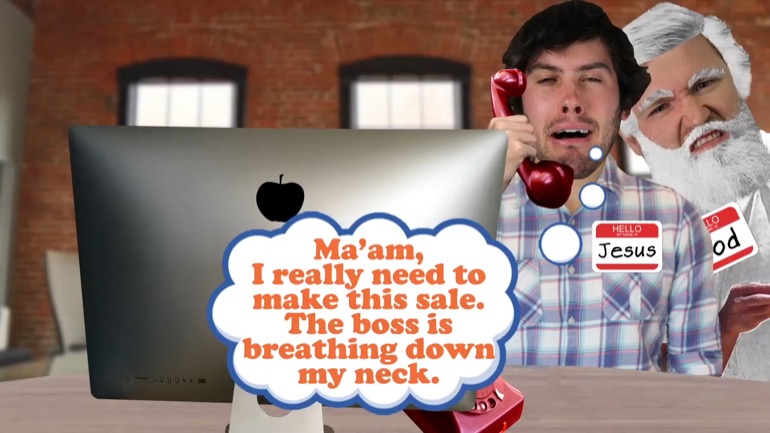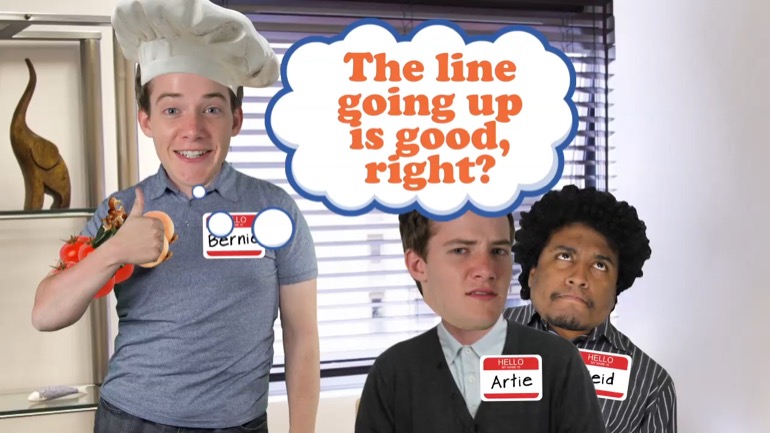ShmoopTube
Where Monty Python meets your 10th grade teacher.
Search Thousands of Shmoop Videos
Finance Concepts Videos 809 videos
What is the difference between federal and state taxes? Federal taxes: the whole country. Taxes for national defense, interstate roadways, national...
What is the difference between stocks and bonds? Stocks are ownership. They control the election of the board of directors, who hires the CEO, who...
What rights does a public stockholder have? Common shareholders elect the board of directors. They vote. They have the right to quarterly financial...
Principles of Finance: Unit 1, Raising Capital: Line of Credit and 409a Valuation 19 Views
Share It!
Description:
How do you raise capital? What's a line of credit? What are 409a valuations? What is that buzzing noise? Who are you? What do you want from us? What are you doing with that weed-whacker? Sorry... we went a little question crazy for a second there.
Transcript
- 00:00
principles of Finance a la shmoop. income statements, margin operating
- 00:05
profits and more. all right so we're still following the sauce company. let's [projector screen]
- 00:11
roll the clock forward so tree grows another ring. all right well the first
- 00:14
year goes gangbusters for the sauce company. the company was able to lease a
- 00:19
bottling facility which they came to call their own. Reed, through his contacts
Full Transcript
- 00:24
in the banking industry helped Artie and Bernie secure trade credit, meaning the [trade document]
- 00:28
loans from suppliers. the various supplies oils onions garlic brown sugar
- 00:33
and a secret greenish powder are all kept under tight lock and key. the
- 00:38
packaging is approved by Bubbe, it's a 17 year old picture of her smiling ,but she
- 00:43
said the buyers don't have to know it was taken at the boys bar mitzvah. at [mom smiles with her boys]
- 00:46
year-end fifty store chains are carrying the sauce. the product has become kind of
- 00:51
a kitschy fun thing that retailers love hanging on their shelves. and by the way
- 00:56
getting into fifty store chains was no easy feat. Artie and Bernie only got [map of the US]
- 01:01
there because Reed had those relationships and was respected enough
- 01:04
by the chain owners to take a risk on the sauce, and well, that risk has paid
- 01:08
off handsomely. the stores benefited in other ways because of the newness of the
- 01:13
sauce ,they were able to take a relatively very large cut or percentage [line of bottles of sauce]
- 01:17
of the sales of each bottle. a bottle of the sauce sells to Joe Sixpack for eight
- 01:22
bucks. the store keeps four bucks. the stuff inside the bottle costs the sauce
- 01:26
company corporation two bucks, leaving two bucks for overhead. that is the
- 01:31
salaries of Artie and Bernie marketing shipping delivery legal costs insurance
- 01:35
and so. on lest you think we don't heart chart well, here you go. well to the sauce [chart shown]
- 01:40
company corporation they only care about four bucks they get per bottle from the
- 01:44
stores .those four bucks are their revenues per unit. the fact that each
- 01:50
unit costs two bucks implies that the sauce company corporation keeps two
- 01:54
bucks a unit in profit or has a 2/4 or yes fifty percent gross margin. and no
- 02:01
gross is not a pejorative word about a spilled bottle, rather it is one of the
- 02:06
delineations of profits. so there's gross margin which is the [bottle of spilled bbq sauce]
- 02:10
profits after the basic unit or product is sold and it doesn't count
- 02:14
anything else. alright further on down you have operating profits which are
- 02:18
profits after you've sold the bottle or paid for it, and then after all of the
- 02:22
salaries of the employees are paid and after lawyer fees and other [definitions on screen]
- 02:27
infrastructure costs. well operating profits are basically all the profits
- 02:30
accept taxes and dividends hence they're operating. it's just profits from the
- 02:35
actual operations of the company. and then there are net profits which are the
- 02:40
famous bottom line. net profits are profits after everything that is you [definitions]
- 02:46
know thereafter cost of goods cost of overhead costs of taxes dividends and so
- 02:51
on. so check out the performance of the sauce company after the first year.
- 02:55
here's the income statement for year one well that's one point two five million
- 02:59
dollars in revenues. not bad for a first year startup. note that when Reed funded [man smiles from doorway]
- 03:04
the company with his half million bucks the company had almost no revenues. Reed
- 03:10
had valued the company at one point five million dollars post, meaning after he'd
- 03:15
put in his five hundred grand, which was at the time almost infinity times
- 03:19
revenues. now after year one the valuation there is just one times
- 03:23
revenue roughly. not a very huge multiple in this kind of fast growth via product
- 03:28
in industry. and revenue multiples in a vacuum mean almost nothing really low [vacuum sucks up paper]
- 03:32
margin companies trade at low multiples of revenue. but there used to calculate
- 03:37
things when you have nothing else - cuz the company has no earnings at this
- 03:40
point only a promise of earnings in the future. however at first blush it looks
- 03:44
like the sauce company corporation should be eventually a pretty high [chart]
- 03:48
margin company. over time their gross margins should trend above 50% and with
- 03:54
scale, overhead, like all the infrastructure costs as a percentage of
- 03:58
revenues should come down a lot well. at the moment Reed is guessing that they
- 04:01
are a 30% operating margin business at scale. meaning if they sold a zillion
- 04:06
dollars worth or well let's just say a hundred million dollars worth of bottles
- 04:10
well they'd have a twenty percent net margin business. meaning on a hundred
- 04:14
million of sales the sauce company would have twenty million dollars of after-tax
- 04:19
profits. how does he get there? he just made it up! he just looked at their gross [pie chart]
- 04:23
margins of 50% and thought well maybe in the future
- 04:26
these 60 or 65 and there's operating costs, which he'll subtract but like how many
- 04:30
secretaries you need how many parking lots do you need how many office square
- 04:34
feet do you need and then he kind of imputed what the tax rate might be at
- 04:37
the time. well read notes that the average S&P 500 large public company
- 04:43
trades today at fifteen times earnings, and that the sauce company is growing
- 04:47
much faster than almost all of those companies, so it should trade at a much
- 04:52
higher multiple. well what's an average S&P 500 company? you know like Bank of [bank of America logo]
- 04:56
America and caterpillar Tractor and GE. but even at fifteen times
- 05:00
the sauce company's projected twenty million dollars of profits well Reed
- 05:05
things the company could be worth well over three hundred million dollars.
- 05:09
that's a huge windfall return on his original 500 grand investment, you know
- 05:14
if they execute and actually put up the numbers .all right we'll note some other
- 05:17
important elements in their first year's income statement. one they made a bit [income statement]
- 05:20
less than four bucks a unit. some of the larger stores were able to negotiate to
- 05:25
keep five dollars on the $8 selling price, and this was a reasonable deal for
- 05:29
the sauce company to do .being in a few Walmart stores while they keep less
- 05:33
money, help the awareness of their product get out there. was almost like
- 05:37
advertising they were just happy to be included in the Walmart shelving. Two, [sauce on a shelf]
- 05:41
their expenses were a bit more than they had originally thought, a common problem
- 05:46
in startups. so the gross margin was 42 percent instead of the 50% that they had
- 05:51
been modeling. over time with size and scale and more negotiating leverage
- 05:56
against the onion suppliers and frankly with better management, they'll be able
- 06:00
to garner more favorable pricing. all right three they're losing money. just a [ men stand in front of farm]
- 06:05
little. in year one they lost fifty five thousand dollars or four cents a share.
- 06:08
assuming that the company gets sold for more than 1.5 million dollars, well, all
- 06:12
of the shares would convert to being one class. so that's how we got that four
- 06:16
cents a share there they're all converted. but this is just year one
- 06:19
people. if all goes as planned while the years that follow will be awfully good [documents]
- 06:23
to our sauce making heroes. so yeah not all heroes wear capes,
- 06:27
some wear aprons. [woman in apron]
Related Videos
How are risk and reward related? Take more risk, expect more reward. A lottery ticket might be worth a billion dollars, but if the odds are one in...
How do credit card companies work? Credit card companies are, in a way, lenders. They give consumers a rectangular piece of plastic that allows the...
How do some accountants “cook the books”? Cooking the books refers to accountants making company’s financials look much better than they are....
How do you become incorporated? Go to Legal Zoom. Pay $150, file with the state of Delaware or whoever each year. Pay another $150. Most file as LL...
How do you get a startup funded? Depends if we're talking about a tech startup, or a non-tech startup. If you've got a promising, budding tech comp...




































































































